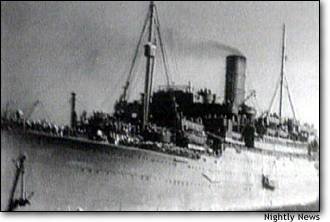|
Three of the men
listed on this memorial, Frank Ballerino, Michael Carr, and Michael Yachus
(spelled Yatzus on the monument) died together when the troop transport
HST Rohna was struck by a German guided glider bomb and sank of the coast
of North Africa. 1,015 men were lost, but the story was never told to the
families or the general public for over 57 years due to wartime
censorship. All three had been stationed at Camp Atterbury.
Remembering the
HST Rohna

The HST Rohna, a British vessel carrying
American troops, was hit by a German missile in 1943 off the coast of
North Africa.
By
Tom Brokaw NBC NEWS
Dec. 27 —
Fifty-seven years ago, a ship
went down off the coast of North Africa and the U.S. Army suffered it’s
largest loss on the water of World War II. But most people have never
heard of this tragedy. It’s been a deeply held secret until recently.
THE DAY AFTER
Thanksgiving in 1943, the HMT Rohna, a British transport ship carrying
American soldiers, was hit by a German-guided bomb and sank off the coast
of North Africa.
One thousand fifteen American troops died that afternoon. The
memories haunt the survivors of the greatest loss at sea of U.S. personnel
in World War II.
“I was glancing over where the bomb had hit and where there had
been soldiers there was just a pile of ashes,” said Al Stephanoni who had
never learned to swim and fought to stay afloat. “There were bodies strewn
here and there.”
Bill Caskey lost his five closest friends.
“A lot of them were yelling for their mothers, ‘Mama, mama,’” he
said, “and a lot of them were yelling, praying.”
THE SECRET WEAPON
The packed ship - almost 2,000 on board altogether — was part of a
convoy bringing troops to Burma when 35 enemy aircraft attacked.
Hitler’s arsenal included a secret weapon.
“I saw this projectile coming toward us,” said survivor Bob Brewer.
“It looked like a kamikaze-type thing happening, but of course it was a
guided missile being controlled by the bombardier on the aircraft above.”
The blast tore truck-sized holes on both sides of the ship and knocked
out the engine room. More than 300 men died instantly.
Help did arrive - an incredible rescue effort under constant air
attack. In 15-foot seas the USS Pioneer, a minesweeper, rescued 606
survivors.
“Out of nowhere that ship could have risen from the deep sea,” said
Stephanoni, “or fallen out of the sky and a sailor threw me a rope.”
The Rohna’s sinking ranks as one of the worst maritime disasters in
history, but wartime censorship blacked out the news. “Hundreds
never knew of their sons, their husbands, their brothers, their uncles,”
said Brewer.
Intended to prevent the Germans from knowing just how successful
their guided bomb had been, the blackout kept the tragedy shrouded in
secrecy for 57 years.
“We are survivors,” Brewer said. “We lived to tell about it, to
tell the public at large that it happened. A lot of people don’t believe
it ever happened.”
Brewer and other survivors mounted a crusade to remember the men on
the Rohna.
Finally, in October this year, Congress officially recognized the
heroes of the Rohna, a tragedy in which 1,015 GIs lost their lives 57
years ago.
Courtesy of
Phil Cohen, Camden NJ
www.dvrbs.com/Camden,NJ-WW2-8thWardMemorial.htm |
|
Thank you very much for your very helpful website. I was able to find
out what happened to a family member who lost his life 26 Nov 1943 as
part of the 31st Signal Construction Battalion aboard HMS Rohna.
Although the soldier that my family lost was not an Indiana soldier, it
was interesting to find your site since my brother was born at Camp
Atterbury in 1952. I think that his father, Joseph Russell Cruciani, and
probably also my grandfather on my mother's side, Col Roy F Blackmon,
Signal Corps, were stationed there at the time.
Kim Baldacchino |

